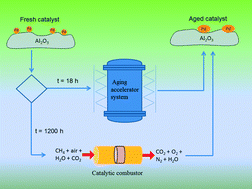Accelerated hydrothermal ageing of Pd/Al2O3 for catalytic combustion of ventilation air methane†
Abstract
In this report, the characteristics of Pd/Al2O3 catalyst after long-term stability tests in catalytic combustion of simulated ventilation air methane gas were investigated with the objective of understanding catalyst deactivation phenomena. It was found that the deactivation is primarily due to palladium migration and particle growth and is the most prominent in the presence of water vapour. The formation of α-Al2O3 during long-term stability tests explains the changes in pore structures which is responsible for re-dispersion of palladium particles. Four accelerated ageing procedures were performed with an aim of mimicking the properties of used catalysts which have been operating continuously for extended time periods (over 1100 h). XRD patterns of aged catalysts disclose the absence of an alpha-alumina phase, suggesting that the transformation of alumina phase occurred at a very slow rate. Among the four procedures, ageing under wet-oxidizing atmosphere provides the catalyst bed that is the best match to the properties of long-term used catalysts in terms of performance and the characterization employed. Increasing the aging temperature up to 830 °C leads to depletion of surface palladium, which permanently reduces the performance of the catalyst.


 Please wait while we load your content...
Please wait while we load your content...